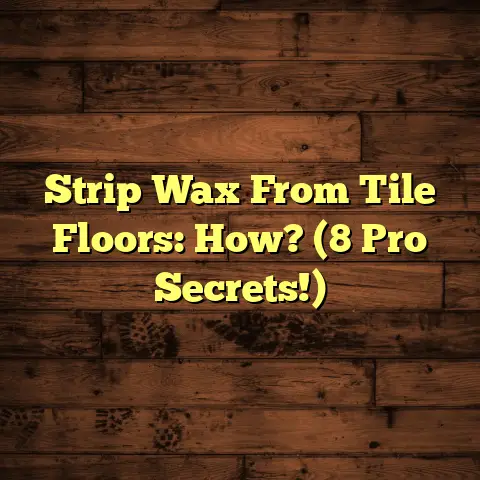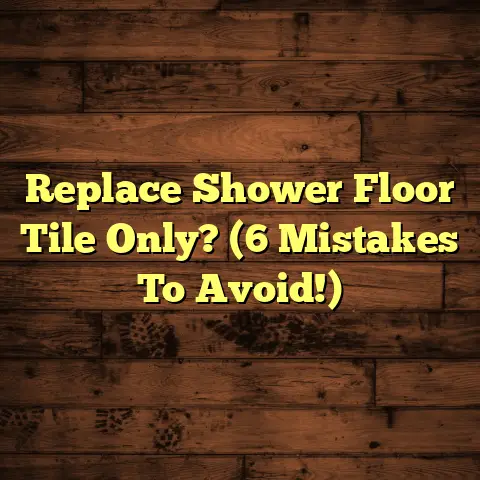Guide to Refinishing Hardwood Floors in Canada
Refinishing hardwood floors can breathe new life into your home, enhancing both aesthetics and property value. However, understanding the costs associated with this process is vital for homeowners. This guide provides an in-depth look at the factors influencing the cost of refinishing hardwood floors in Canada, comparing options, and offering insights into maintenance and care.
Overview of Major Cost Factors
When estimating the cost of refinishing hardwood floors, several key factors come into play:
1. Area Size
The total square footage of the area being refinished is a primary cost determinant. Typically, refinishing costs are calculated per square foot. The larger the area, the higher the total cost, although the price per square foot may decrease slightly for larger projects due to economies of scale.
2. Hardwood Type
Different species of wood, such as oak, maple, or cherry, have varying costs. Exotic woods tend to be more expensive than domestic varieties. The density and hardness of the wood can also impact the refinishing process; harder woods may require more labor and specialized equipment.
3. Labor
Labor costs vary by region and the expertise of the contractor. Hiring skilled professionals might incur higher costs but ensures quality work. In urban areas, labor rates tend to be higher due to demand, while rural areas may offer more competitive rates. It’s essential to evaluate not just the cost but also the contractor’s reputation and experience.
4. Additional Considerations
- Floor Removal: If old flooring needs to be removed before refinishing, this will add to the overall cost. The removal process can vary in complexity depending on how the original flooring was installed.
- Subfloor Replacement: Damaged subfloors may require replacement, increasing expenses. A thorough inspection before starting the refinishing process can help identify potential issues.
- Material Grade: Higher-grade materials will typically result in higher costs. The grade of hardwood affects aesthetics and durability; lower grades may have more knots and imperfections.
- Room Size/Layout: Larger or more complex layouts may require more time and resources. Open-concept designs might allow for quicker refinishing, while smaller rooms with many angles and corners could increase labor costs.
- Installation Type: Nail-down, glue-down, or floating floor methods can all impact costs. Each installation method has its pros and cons and may require different levels of expertise.
- Wood Type: Engineered hardwood may have different refinishing costs compared to solid hardwood. Engineered hardwood often has a thinner veneer layer that limits how many times it can be refinished.
Detailed Cost Breakdown
Average Refinishing Costs
On average, refinishing hardwood floors in Canada ranges from CAD $3 to $8 per square foot, depending on various factors mentioned above. Below is a breakdown based on project sizes:
| Project Size | Estimated Cost (CAD) |
|---|---|
| 100 sq ft | $300 – $800 |
| 500 sq ft | $1,500 – $4,000 |
| 1,000 sq ft | $3,000 – $8,000 |
| 1,500 sq ft | $4,500 – $12,000 |
Cost of Different Hardwood Types
The type of hardwood significantly affects cost:
- Domestic Woods (e.g., Oak, Maple): CAD $3 – $6 per sq ft
- Exotic Woods (e.g., Teak, Mahogany): CAD $6 – $12 per sq ft
- Engineered Hardwood: CAD $4 – $10 per sq ft
The choice of wood also influences the finish options available. Some woods take stain better than others, affecting both appearance and maintenance.
Comparison with Other Flooring Options
When considering refinishing hardwood floors versus alternative flooring options, it’s essential to evaluate both costs and benefits:
| Flooring Type | Cost Range (CAD) | Durability | Maintenance Needs |
|---|---|---|---|
| Hardwood | $3 – $12 per sq ft | High | Moderate |
| Laminate | $1 – $5 per sq ft | Moderate | Low |
| Vinyl | $2 – $8 per sq ft | High | Low |
| Carpet | $2 – $6 per sq ft | Low | High |
Additional Considerations in Flooring Choices
1. Durability
Hardwood floors are known for their durability and can last many years with proper maintenance. In contrast, laminate and vinyl flooring may need to be replaced sooner due to wear and tear.
2. Aesthetic Appeal
Hardwood offers a timeless beauty that many homeowners prefer over synthetic alternatives like laminate or vinyl. The natural grain patterns and warmth of hardwood provide a unique character that is difficult to replicate.
3. Resale Value
Investing in hardwood flooring can significantly increase your home’s resale value compared to other flooring options. Many buyers prefer homes with hardwood floors for their aesthetic appeal and durability.
Signs Your Hardwood Floors Need Replacement
Identifying when to refinish or replace hardwood floors is crucial for maintaining your home’s appearance and structural integrity. Signs include:
1. Deep Scratches or Gouges
If damage is beyond surface-level scratches and affects the wood’s integrity, it may be time for replacement instead of refinishing.
2. Water Damage
Buckling or warping indicates significant damage that could compromise the entire floor structure. Water damage often requires not just refinishing but possibly replacing affected sections or even the entire floor.
3. Severe Fading or Discoloration
When refinishing can no longer restore the original appearance of the wood, replacement might be necessary. Excessive fading can occur from sun exposure or improper cleaning products.
4. Cupping or Crowning
These conditions indicate moisture issues that may compromise floor integrity. If cupping persists after refinishing efforts, replacing the flooring may be required.
Pros and Cons of Hardwood Flooring
Pros
- Aesthetic Appeal: Adds warmth and beauty to any space.
- Durability: Can last decades with proper care.
- Increased Home Value: Often considered a premium flooring choice.
- Versatility: Available in various styles and finishes to match any decor.
- Renewable Resource: Can be sanded and refinished multiple times.
Cons
- Cost: Higher initial investment than some alternatives.
- Maintenance: Requires regular upkeep to maintain appearance.
- Susceptible to Damage: Can be affected by moisture and heavy impact.
- Noise: Hardwood floors can amplify sound if not properly insulated.
- Temperature Sensitivity: Wood can expand and contract with temperature changes, potentially leading to gaps.
Cost Differences: Professional Installation vs. DIY
Professional Installation
Hiring a professional typically ranges from CAD $2 to $6 per sq ft for labor. Benefits include:
- Quality Assurance: Professionals have experience and knowledge about best practices.
- Proper Tools and Equipment: Specialized tools ensure a high-quality finish.
- Time-Saving: Professionals can complete projects more quickly than DIYers.
While professional work ensures quality results, it’s essential to select a contractor with a good reputation and positive reviews from past clients.
DIY Installation
DIY can save on labor costs (approximately CAD $2 – $4 per sq ft), but consider:
- Tool Rental or Purchase Costs: Investing in quality tools could add significant upfront costs.
- Time Investment: DIY projects can take much longer than expected, especially without prior experience.
- Skill Requirements: Proper installation requires knowledge of techniques that prevent future issues.
Pros and Cons of DIY Installation
Pros
- Cost Savings: Reduces overall project expenses by eliminating labor costs.
- Personal Satisfaction: Completing your own project can be rewarding.
- Customization Options: Allows for personal choices in materials and finishes.
Cons
- Risk of Mistakes: Inexperience can lead to costly errors requiring professional correction.
- Time Consumption: Projects may take longer than anticipated without professional efficiency.
- Potential Lack of Quality: Without experience, achieving a high-quality finish can be challenging.
Questions to Ask Hardwood Flooring Contractors
When hiring a contractor, ensure you ask the following questions:
- How many years of experience do you have in hardwood refinishing?
- Can you provide references from previous clients?
- What type of finishes do you recommend?
- What is your estimated timeline for this project?
- Will you obtain necessary permits?
- Do you offer a warranty on your work?
- How do you handle unexpected issues during the project?
- What are your payment terms?
- Will you provide a detailed written estimate?
- Can you explain your process for preparing the floor before refinishing?
Hardwood Floor Care and Maintenance Tips
Maximizing the longevity of your hardwood floors requires consistent care:
1. Regular Cleaning
Use a soft broom or vacuum designed for hardwood regularly to remove dirt and debris that can scratch surfaces.
2. Avoid Excessive Moisture
Wipe spills immediately with a dry cloth and use a damp mop sparingly; too much water can damage hardwood.
3. Use Protective Pads
Place these under furniture legs to prevent scratches and dents from heavy items.
4. Maintain Humidity Levels
Use a humidifier in dry months to prevent cracks or separation between boards due to low humidity.
5. Refinish Periodically
Depending on wear, refinishing every 5 to 10 years can keep floors looking fresh; additional coats of polyurethane can also help maintain shine.
Environmental Considerations
When selecting hardwood flooring or refinishing materials, consider environmentally friendly options:
Sustainable Sourcing
Look for certifications like FSC (Forest Stewardship Council) that ensure responsible forestry practices are followed in harvesting timber.
Low-VOC Finishes
Choosing low-VOC (Volatile Organic Compounds) finishes minimizes harmful emissions during application and drying periods, contributing to better indoor air quality.
Choosing the Right Finish
The finish applied during refinishing not only impacts appearance but also durability:
Types of Finishes
- Oil-Based Polyurethane: Offers durability and warmth; however, it has a longer drying time and stronger odor.
- Water-Based Polyurethane: Dries quickly with low odor; it’s less durable than oil-based but offers clarity in finish.
- Alkyd Oil-Based Finishes: Traditional option providing a rich color; however, it takes longer to dry.
- Natural Oils: Eco-friendly options that penetrate wood but may require more frequent reapplication.
Selecting the Right Finish for Your Home
Consider factors such as:
- The level of foot traffic in the area (higher traffic areas may need more durable finishes).
- Desired appearance (glossy vs matte).
- Maintenance preferences (some finishes are easier to maintain than others).
Conclusion
Refinishing hardwood floors in Canada can significantly enhance your living space but requires careful consideration of various cost factors and maintenance needs. By understanding the nuances of pricing and the benefits of hardwood flooring compared to alternatives—along with recognizing when it’s time to refinish or replace your floors—you can make informed decisions that best suit your home and lifestyle.
Whether opting for professional help or taking on a DIY project, prioritizing quality materials and workmanship will ensure lasting beauty in your hardwood floors for years to come. By following best practices for care and maintenance, you can enjoy stunning hardwood floors that not only elevate your home’s aesthetic but also withstand the test of time.
By compiling all this information into a single comprehensive guide, homeowners can navigate their hardwood flooring projects with confidence, ensuring they make choices that align with their budgetary constraints while achieving their desired outcomes in terms of style and functionality.





